Vacuum Suction (Cupping)
Many early beauty treatments for wrinkles, crépy throats and double chins were based on improving blood circulation. Some form of compression or tapping massage was the most common manual treatment used to increase blood flow to the skin but beauty culturists also used partial vacuums.
Vacuum suction or cupping, was also used to treat a range of ailments in quasi-medical establishments such as the Battle Creek Sanitarium established by J. H. Kellogg.

Vacuum device being used at Kellogg’s Battle Creek Sanitarium.
Beauty culturists used vacuum suction – also known as vacuum massage – to improve circulation, remove waste products, break down fat and plump up underdeveloped or hollow parts of the body. The effect is the same as sucking your finger to make it go red; the mouth creates a partial vacuum drawing blood to the surface. It was used on the face to draw blood to the surface to improve sallow complexons and reduce wrinkles, on the neck to reduce double chins, and on the body to assist with weight loss.
Vacuum suction became a standard treatment in many salons, particularly after the arrival of the electric pump. The improved suction and the addition of specialised attachments meant they could also be used to extract skin eruptions such as blackheads and pimples.
See also: Blackheads
However, some expressed concerns about these treatments.
Pulling a tooth relieves toothache—but the resulting cavity is not to be desired. Pulling the contents from the glands of the face certainly produces noticeable results—but the depletion of natural secretions is certainly not to be desired.
Fancy what must be the result of a powerful sucking, “lifting-up” action upon all the delicate mechanisms of the skin. Imagine how the tiny muscles are strained and distorted. Think how the minute tiny blood vessels are gorged with an unnatural supply of blood.
And the precious little fat cells—what may happen to them? If the action is strong enough, or too long continued, they are disturbed perhaps even loosened and carried away.(Princess Pat, 1923, p. 9)
Home treatments
Home treatment devices made mainly from rubber were also sold. Some of these vacuum-based products, such as those that claimed to cure baldness or enlarge the bust, enjoyed a degree of notoriety perhaps only matched by the vacuum-based penile enlargement machines prevalent on the Internet today.

1903 Bust ‘enlarger’ using a hand pump to generate a partial vacuum.

1910 Vacuum Cap using a hand pump to ‘grow hair’. It must have been difficult to get a good seal.
Domestic devices to improve the skin included small rubber cups, simple rollers with rubber cups and more complex machines that used foot pumps or running water to produce the suction. Small vacuum-suction devices for use at home are still sold today, usually made from silicone.
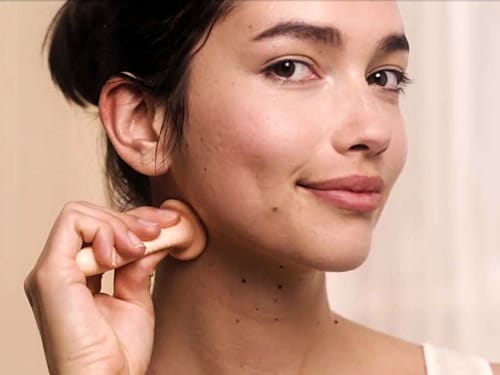
Payot Cup de Massage.
Cupping
No matter how complex the apparatus, or whether they were used on the face or the body, all the devices sold for the past one hundred years or more were based on the generation of a partial vacuum under some form of cup. The practice of cupping goes back into prehistory. The ancients used it therapeutically to treat a wide range of conditions including hemorrhage, snake-bite and blood-letting. They made cups using natural hollowed containers such as shells, horns, bamboo or bones. In some cases heat was used to generate the partial vacuum but implements such as horns could also have the air sucked out of them through a hole at the top, after which they would be stoppered.
Mechanical devices
Cups: Simple cupping has been utilised in Beauty Culture in the past and has seen a resurgence in recent times in salons that specialise in natural therapies, particularly those that use Asian techniques. In the past the cups were generally made from glass or rubber surmounted by a soft rubber bulb that was used to generate the partial vacuum.

Above: Vacuum massage cup with glass cup and rubber bulb.
Rollers: Small suction cups were added to mechanical facial massagers such as rollers adding the lifting action of suction to ‘smooth out wrinkles’.
The cup shaped teeth have a suction effect on the skin that smooths [sic] out wrinkles, rounds out the beauty muscles, and gives perfect circulation to the blood.
It is so constructed that it treats every portion of the face and neck perfectly, even to the “crow’s feet” in the corners of the eyes.(Bailey’s Rubber Massage Roller advertisement, 1902)
Hydro-Vacu: This apparatus was an ingenious mechanical device that used water fed by gravity to cleanse and massage the face. Although advertised for the home market it was also used commercially in American beauty salons and barber shops.
The “Hydro-Vacu” is a scientific invention which sprays hot water on the face, thus loosening up all the impurities and hardened oily secretions, while at the same time a small vacuum cup passes over the face, sucking out and washing away all the impurities, leaving the skin clear and pink as a child’s. Pimples, wrinkles, fleshworms, eczema and eruptions of all kinds cured quickly.
(Hydro-Vacu advertisement, 1896)
The bag containing the water was placed about two metres from the floor connected to an outlet which was put in a bucket with enough water to cover the end of the tube. After the cup was placed on the skin, a valve was opened and the cup worked over the face. The contents of the bag could be altered depending on the needs of the client – lukewarm water with a little borax for normal skin, hot water if the face was oily or had blackheads. A second treatment using cold water, with or without an astringent, could follow the first to ‘harden the muscles and close the pores’.
Hang the bag about six feet from the floor and place the outlet tube in pail with sufficient water in it to cover end of tube. Wipe the face with a small towel or napkin, removing all cream. Now place the Depurater [cup] on the face, open the clasp and move slowly upward on the mouth line (the line running from outside of nose to the corner of the mouth) to the nose, across the cheek, up to the temple and down across the little lines which form under the eyes. Move the automatic massage slowly across these fine lines and work in a circle around the cheek bone, avoiding the lines at the corner of the eye. Work on the temples and across the forehead in circles, always remembering to move slowly. After finishing one side of the face, work across the chin and do the other side in the same manner. If plump cheeks are wished for, work in circles where plumpness is desired. If the face is a young one with no heavy deep-set lines all that is now necessary is to rub in the Tissue Food, thoroughly cleanse and follow with another Automatic Massage [Hydro-Vacu] Treatment using cold water in place of warm as before described. The cold water hardens the muscles and closes the pores. If an astringent is desired, use a small piece of alum in the cold water. An astringent is desirable where the pores are coarse.
(Moler, 1905, pp. 106-107)
Clean-O-Pore: This device, although still mechanical, is close to modern salon machines. It uses a technique – still used in some scientific laboratories to generate a partial vacuum – that requires a connection to a running water tap. Unlike the Hydro-Vacu, it would not have sprayed water onto the face and would have relied on the partial vacuum alone to achieve its aims. Its main claims were to ‘cleanse the pores’ and ‘increase blood circulation’ thereby ‘nourishing and purifying all the parts on which it is used’. The device came with cups of different sizes for the face, scalp and body so that it could also be used to ‘build up the bust’ and ‘invigorate the scalp’ – a code for helping to stop hair loss.
Use it on face, scalp or any part of the body—see for yourself how it improves your appearance by stimulating a vigorous circulation that feeds to tissues and carries away impurities—how it brings color to the cheeks and a sparkle to the eyes—how it cleans the pores, smooths out wrinkles and makes firm flesh—how it builds up the neck, bust or other hollow parts of the body—soothes and strengthens the nerves, and relieves headaches—how soothing it is after shaving—how it invigorates the scalp and hair and takes out dandruff.
(Clean-O-Pore advertisement, 1920)
Electrical devices
There were two ways in which electricity was used with vacuum suction devices. The first, and the earlier process, was to add an electrical current to the fluid, the second was to use electricity to power the pump that generated the vacuum.
Electrolytic cup: These devices had an inlet tube made of metal to which a negative electrode could be attached. The client would need to hold the positive electrode to complete the circuit. As the fluid from the supply tank passes through the inlet tube it was ‘charged with electricity’ before coming in contact with the skin of the client.
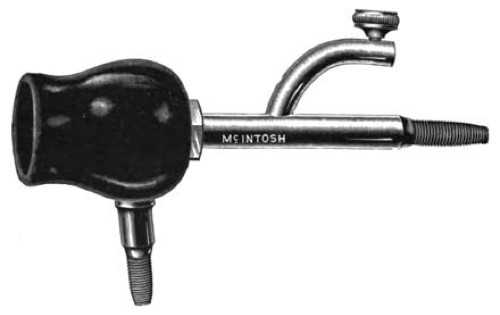
Above: An electrolytic cup.
See also: Electrolytic Cup
The fluid would need to contain salt or some other substance for the charge to be conducted. The galvanic (direct) current produces an alkali (sodium hydroxide) at the negative electrode which was said to help cleanse the skin, open up the pores and loosen hard plugs of sebum. Its action was therefore similar to desincrustation.
See also: Desincrustation
The electrolytic cup disappeared from use when the water-gravity feed was replaced by an electric pump to create the vacuum suction. As the low pressure created by the electric pump was done by pumping out air there was no salt solution to enable the passage of an electric current.
Derma-Vac Facial System: This machine was an American device consisted of an electric pump to generate the partial vacuum connected by rubber tubing to a series of glass cups. Each cup was connected to a manifold protector packed with cotton wool to protect the pump from taking in foreign matter picked up during the treatment. The airflow, and therefore the strength of the vacuum, was regulated by opening and closing a pet-cock, a small tap attached to the tube where it connected with the pump. Although not as sophisticated as modern regulators, a skilled operator would have been able to make appropriate adjustments with the pet-cock to avoid damaging the skin.
The device was used in the treatment of acne, enlarged pores, blackheads, wrinkles and skin blemishes using specialist cups in combination with the cleansing cream, skin freshener and skin food supplied by the manufacturer.
Incredible as it may seem, science has bought us an apparatus called the Derma-Vac that does what its name implies, vacuum cleans the derma so thoroughly and scientifically that blackheads and impurities are entirely removed from the pores without bruising the skin in any degree. The results are astonishingly remarkable. The large chocked pores, relieved of their deposit and kept clean, are thus given an opportunity to contract to normal size.
This result is hastened by the Derma-Vac because it also stimulates the circulation, strengthens the tissue and restores normal functioning of the skin glands so that the elasticity of the skin is restored. The Derma-Vac not only gives absolute skin cleanliness but it gives the skin health and normalcy and keeps it in that clear, rosy translucency and brilliance of the beautiful skin that we all admire so much. Also the Derma-Vac, by increasing the blood supply, renourishes the tissues and strengthens the facial muscles and in this way the fine lines and wrinkles are eliminated and the sagging muscles are restored to firmness.(Clean-O-Pore advertisement, 1920)
Modern machines: Vacuum suction machines can still be purchased for the face and body, either as stand-alone units or in combination with other electrical treatments. They are equipped with a range of cups generally made of Plexiglas or clear Perspex. The therapist needs to carefully monitor the amount of suction used, otherwise surface capillaries may be damaged.
Although these machines are still used to ‘reduce wrinkles’ it is not common for this claim to be made today. The usual benefit claimed for vacuum suction machines is that they ‘speed up the removal of wastes via the lymphatic system’ and ‘increase blood circulation, thereby improving the condition of the skin’. In general, it is lymphatic drainage that is mentioned, not improved circulation, and this affects how the machines are used.
One widely used treatment is the ‘gliding cup method’ in which the therapist guides the cup across the skin in the direction of the nearest lymphatic node, supposedly to help remove ‘excess fluids and toxins’. Some units include a pulsating action – sequential pneumatic compression – that lifts and drops the skin in rapid succession, mimicking a tapping or patting massage action (tapotement), only in reverse. The pulsating action can be used either while gliding or when the cup is in a fixed position.

Above: 1967 Lymphatic massage using a Vacuum Suction Machine.
Vacuum suction treatments are also likely to result in some desquamation of surface skin cells, although the amount that occurs would be limited. In addition, although the trend is to leave pustules to the medical profession, specialist nozzles are still included for extractions in machines designed to be used on the face.
Large cups are included in vacuum suction machines designed for body treatments and are used in salons to treat cellulite or to augment a weight reduction program. Their effectiveness is questionable. Cellulite can perhaps be seen as a late twentieth century beauty equivalent of the wrinkles, crépy throats, and double chin problems of the past. Many beauty treatments for it are highly speculative and are unlikely to produce a permanent fix.
See also: Compressed Air Massage
First Posted: 25th November 2011
Last Update: 8th March 2023
Sources
Covery, A. D. (1903). The secrets of specialists. Detroit: Physicians Supply Company.
Cressy, S. (1998). The beauty therapy fact file (3rd ed.). Oxford: Butterworth Heinemann.
Moler, A. B. (1905). The manual on barbering, hairdressing, manicuring, facial massage, electrolysis and chiropody as taught in the Moler system of colleges.
Morris, J. (1987). The beauty therapist’s handbook. London: B. T. Batsford Limited.
Princess Pat. (1923). The promise of a princess [Booklet]. Chicago, IL: Author.
Rosser, M.(1999). Body therapy and facial work. Electrical treatments for beauty therapists (2nd ed.). London: Hodder & Stoughton.
Smith, A., & Rockwood, R. (1935). Modern beauty culture. New York: Prentice Hall.
W. M. Meyer Co. (1936). The cosmetiste: A textbook on cosmetology with special reference to the employment of electricity in the care of the hair, scalp, face, and hands, also permanent waving and hair curling (9th ed.). Chicago, Ill: Author.
Woodbury, W. A. (1911). Beauty Culture. A practical handbook on the care of the person, designed for both the professional and private use. New York: G. W. Dillingham Company.

1901 Hydro-Vacu. This home treatment was used on skin eruptions and wrinkles.

1902 Bailey’s Rubber Massage Roller.
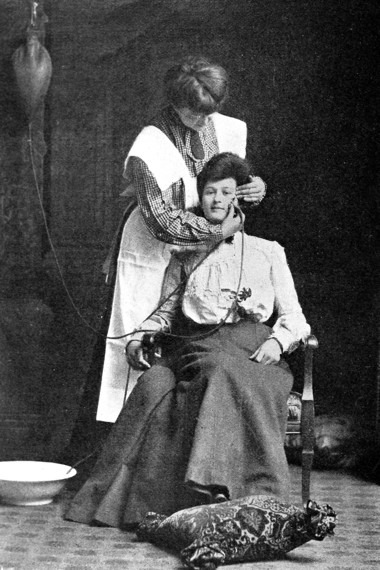
1903 Client undergoing a ‘water massage’ in a beauty salon using a device similar to the Hydro-Vacu.

1905 Simplex Massage Beautifier.

1907 An electrolytic cup being used in a beauty salon. There are no real differences between how the devices were used in beauty salons as compared to quasi-medical situations. The direct current (galvanic) source is the wall unit.

1913 Agents wanted to sell the Blackstone Water Power Vacuum Massage Machine. “Removes Blackheads, Wrinkles, rounds out any part of the face or body, brings back Nature’s beauty”.
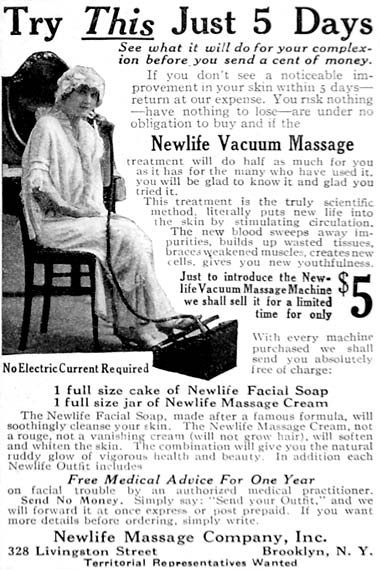
1916 Newlife Vacuum Massage using a foot pump to generate the partial vacuum.

1920 Clean-O-Pore. The machine used water pressure from the tap to generate the vacuum.
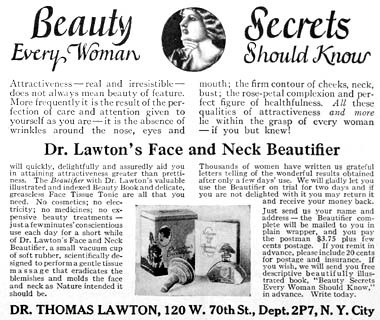
1923 Dr. Lawton’s Face and Neck Beautifier. The device is a simple cup made of rubber surrmounted by a bulb. A secure seal is achieved by first smearing the skin with the Tissue Tonic that came with the kit.
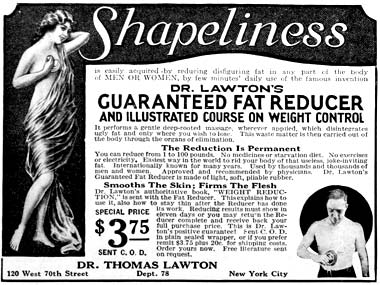
1923 Dr. Lawton’s Guaranteed Fat Reducer. There appears to have been a larger market for devices that reduced fat than for those that improved the contours of the face.
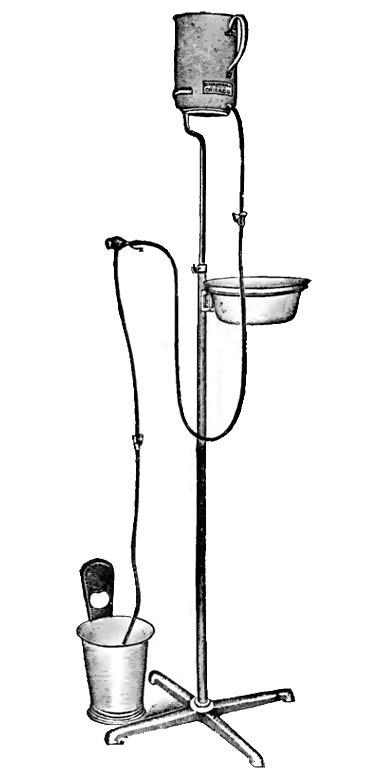
1926 Commercial Hydro-Vacu equipment as used in a barber shop. It is essentially the same as the 1901 home-treatment model.
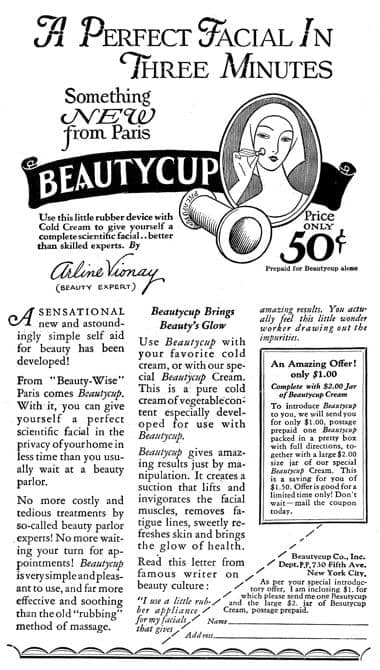
1928 Beautycup. Made from rubber not silicone but essentially the same as devices on sale today.
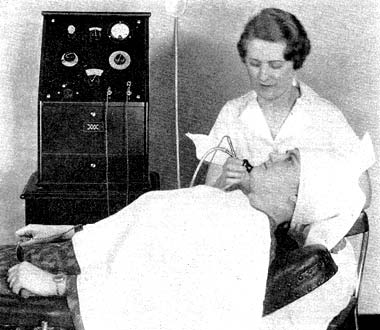
1936 An electrolytic cup being used in a beauty salon.

1936 Derma-Vac. An early commercial electrical vacuum massage machine (WM Meyer, 1936).
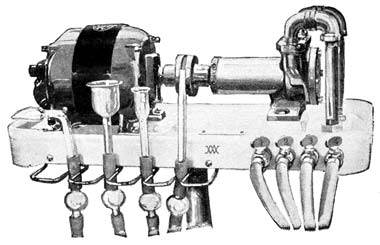
1936 Derma-Vac showing details of the motor for generating the vacuum, cups of different sizes, shape and function, manifold protectors (bulbs) for filtering foreign matter and pet-cocks for controlling the vacuum strength (WM Meyer, 1936).
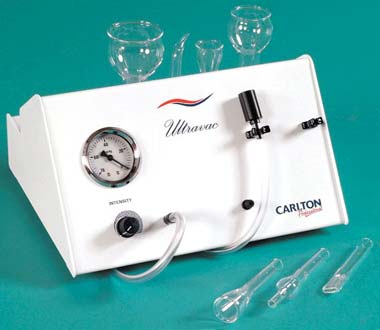
Carlton Ultravac Facial Vacuum Unit. It is more compact and there is more control over the vacuum strength but the unit is similar in many ways to those used in the 1930s.
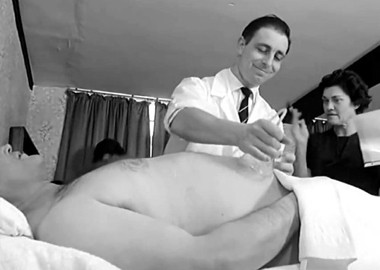
1960s Vacuum suction being used as part of a men’s weight reduction program.

1964 Vacuum suction treatment.

1975 Taxator machine with a range of cups used in body massage treatments.
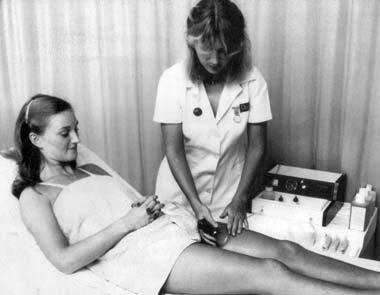
1987 Gliding vacuum massage for lymphatic draining. Thighs, buttocks and stomachs were most commonly treated.
